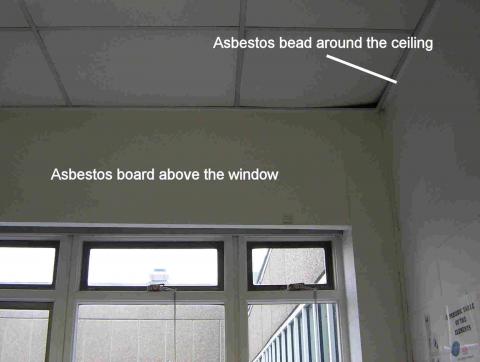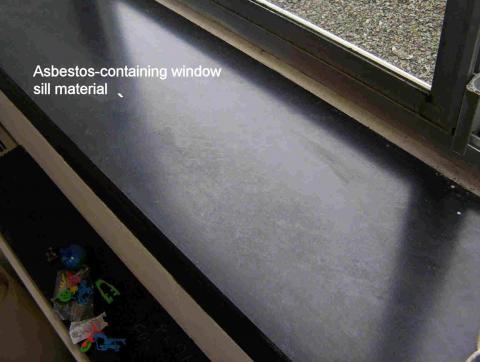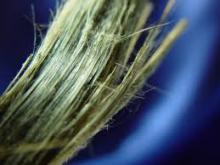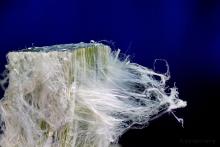Asbestos - information for ALL members of the Department
This page contains the following information:
- Policy
- Departmental Organisation
- Asbestos Materials Present in the Department
- When does asbestos present a danger?
- Prohibitions on work
- Acquisition and transfer of equipment and property
- Training
- What to do if you find some materials that you think could be asbestos, or if a material is damaged
A printable copy of this page is available here (document A2)
Policy
The Head of Department has overall responsibility for identifying and controlling risks in the activities and buildings of the Cavendish Laboratory (i.e. Department of Physics), and has delegated the role of co-ordinating departmental safety arrangements to appropriate members of staff.
The Department will comply with the University policy and procedures on asbestos management, which are administered by the Estates service. Specialist asbestos management advice will also be sought from Estates.
Asbestos materials in good condition may be left in place if they are unlikely to be disturbed. The Estates service asbestos consultant will carry out reassurance air monitoring regularly to ensure exposure to airborne fibres is NOT a significant risk.
Responsibilities
Within Physics, the following post-holders will be responsible:
1) The Facilities Manager and Maintenance Manager (responsible to the Laboratory Superintendent) - will ensure that:
- They have access to the up to date Register of asbestos-containing materials (ACMs) produced by the Estates Division
- No work on the fabric of the older buildings (Mott, Bragg, Link, Rutherford, Garage) is permitted until the Asbestos Register is consulted and any removal work is arranged through the Estates service.
- Co-ordinate the response to asbestos incidents, in consultation with the DSO and/or the Estates Asbestos Information Request service
- They facilitate reassurance and other air monitoring or surveys set up by the Estates Division
- Any damage to suspected asbestos material is reported to Estates and also to the DSO (so an incident report can be raised)
- All members of the Maintenance team have had asbestos awareness training, and cleaning staff are notified of areas where they may damage ACMs, and have been told not to lift suspended ceiling tiles and to avoid even minor damage to the fabric of the older buildings
- When ACMs are removed, the appropriate Clearance Certificates are obtained from the Estates' consultant, and kept for a number of years.
2) The Department Safety Officer (DSO) will ensure that:
- Work inspection or audits are conducted to check that the requirements of the law and Estates procedures are met
- Asbestos-related incidents are reported to UoC the Safety Office
- All lab-related inductions point out the prohibition on disturbing the fabric of the older buildings in case ACMs are disturbed
- Records of asbestos exposure are kept for 40 years, and anyone suspected of having been exposed to confirmed ACMs, is referred to Occupational Health.
3) PIs, managers and other members of the department will:
- Notify facilities@phy.cam.ac.uk or (01223 3)37499 - the Cavendish Emergency number - if they see damage to material suspected of containing asbestos
- Take care not to damage the fabric of the older buildings (Mott, Bragg, Link, Rutherford), which still contain ACMs
- Notify Facilities if they plan buildings works, or even minor disturbance of the walls, such as drilling holes or using screws/nails to put up pictures, clocks, etc.
The Department maintains an action plan in relation to asbestos. (document A4)
Departmental Organisation
| Person of Authority (Head of Department) | Professor Andy Parker |
| Location of Asbestos register Information and Records | Online - controlled by Facilities Manager, Maintenance Manager and Laboratory Superintendent (managed by Estates) |
| Departmental Contact (Person coordinating procedures and records held) | Facilities Manager, responsible to Laboratory Superintendent |
| Contact in absence of coordinator | Maintenance Manager or DSO |
University Contacts
| Estates Division Asbestos Team (Laundry Farm) | 01223 (3)37784 asbestos.management@admin.cam.ac.uk |
Asbestos Materials Present in the Department
The fabric of the building
The West Cambridge and Madingley rise sites contain 9 buildings occupied by Physics.
The following buildings were constructed in the 1970s and it is probable that they are Mark 4B CLASP buildings. These contain a great many asbestos materials within their fabric (walls, ceilings etc):
- Rutherford
- Link (EM usually call this the Workshop building)
- Bragg
- Mott
- Garage
Those that may contain some asbestos materials in the fabric of the building (built between 1990 and 2000) are:
- Microelectronics/Hitachi
- Kapitza (formerly known as IRC in Superconductivity)
Those which were built after 2000, and which do not contain asbestos in the fabric of the building:
- Physics of Medicine
- The Battcock Centre
- The Maxwell Centre
The Lord's Bridge site contains many buildings, all originating in an era when asbestos materials were widely used.
Estate Management commissioned a type 2 survey in 2002, and a follow-up survey was conducted in 2006. These surveys were limited and were unable to identify asbestos materials that were hidden from view. Further surveys are planned.
A detailed 'intrusive' survey is carried out each time work on the fabric of the buildings is necessary as it might result in asbestos disturbance.
All information is kept online in the database systems maintained by Estates and accessible to the Facilities Team.
Typical Asbestos-Containing Materials in Physics Buildings
In the older buildings listed above, the following often contain asbestos:
- Panels above windows and doors
- Panels lining the stairwells
- Battens on the perimeter of suspended ceilings
- Window sills
- An interior layer within the fire doors
- Floor tiles
- Cladding to structural beams
- Deposits above the suspended ceiling tiles (limited areas)
- Under-floor service areas
Many of the visible materials have been labeled with a discreet white label bearing a sample number and a date. Some typical samples are shown in the photographs.
 |
 |
 |
|
The visible asbestos-containing boarding has all been encapsulated or sealed. The condition of these materials is generally good, having been re-inspected and remedial work done and maintained since 2007. While these materials remain in good condition the risk to people entering and/or working in the department is minimal.
The pillars which support the building structure remain an area of concern, as these were originally all clad with asbestos. In some CLASP buildings these have been damaged by furniture movements and, when struck, in some buildings asbestos fibres have been released from the casing. During remediation works in January 2007, air monitoring was carried out by Redhill Analysts, some of it close to pillars. Their report created 23/1/07 indicates that no elevated fibre counts were reported in these buildings.
Old Equipment
Some of the older equipment in the department is likely to contain asbestos. This is most likely in items likely to become overheated, or where heat or fire protection was required, such as furnaces, old heat resistant gloves, and clamps. If you have old equipment (pre 1999), please read Asbestos in old equipment (document A7).
If you have equipment that contains asbestos it is acceptable to continue to use it, so long as:
- it is in good condition
- you notify the Safety Officer, so that it can be entered into the asbestos register
- you inform the people who use the equipment about the presence of asbestos and how to avoid the risk of disturbing it.
Items such as gloves, clamps etc should be wrapped in a sturdy plastic bag, sealed and handed to the Safety Officer for safe disposal. It is illegal and not permitted to transfer equipment containing asbestos to a building that is asbestos-free.
When does Asbestos Present a Danger?
Asbestos is the cause of mesothelioma and lung cancers. For this to occur the fibres must be inhaled and therefore, provided the material does not become airborne, it does not pose a significant risk. There is a lot more information on the HSE website at this location.
Virtually all the asbestos materials that are visible are covered with paint, which encapsulates the material and prevents the release of fibres. Keeping this paint in good condition is therefore a priority. Please do not stick posters to them using blu-tack, sticky tape or by other means. Please avoid hitting the materials or the cladding of the structural steel with tables, chairs, gas bottles, trolleys etc. If you do this by accident, please follow the emergency procedures below.
However, above the ceilings there is some loose sprayed asbestos, which has been there since the buildings were erected. It is important not to disturb this.
Prohibitions on work
No person in the laboratory is permitted to enter the ceiling voids or the sub-floor voids, or to drill into the walls, unless under a safe system of work devised and implemented by Maintenance, supported by the Asbestos team in Estate Management. These restrictions apply to the Garage, Mott, Bragg, Link and Rutherford Buildings.
Acquisition and transfer of equipment and property
Equipment
This includes the acquisition of equipment, whether new or not, the transfer of equipment from one institution to another and the movement of equipment from one building to another.
It is prohibited to newly introduce asbestos materials to any building. This includes items sourced by purchase, import, hire, lease, loan, second hand purchase, gifted or exchanged, as specified within the stipulations of current asbestos legislation. Vigilance is needed to avoid asbestos materials being introduced, especially when a department is moving into new premises.
Property
This includes purchase, lease in, sale, leased out or occupancy of shared space and/or any other informal & temporary arrangements for staff being accommodated in buildings not under the control of the University (See documents A12 and A13)
Estates Property Team must be contacted ahead of all property transactions.
The key actions will include:
1. When disposing of property, ensuring that all relevant asbestos information relating to the property is provided to the purchaser/new lessee.
2. When acquiring property, ensuring that all asbestos information relating to the property is received prior to completion of purchase or grant of new lease.
3. Undertaking an assessment of the current level of asbestos compliance, duty holder identification and inherent asbestos liability.
4. Ensuring the information received is brought up to date and in line with other documents held (e.g. undertake a Management Survey if information is not held for the property).
5. Update the University Asbestos Register – Online Asbestos Register.
Training
All persons whose work makes them liable to come into contact with asbestos, or who manage or supervise such employees require training. Please contact the DSO for current details.
What to do if you find some materials that you think could be asbestos, or if a material is damaged
Please report immediately to the Facilities Team (Facilities Manager or by phone) or if you can't find them, to the DSO, if:
- you discover items that could contain asbestos, e.g. old Bunsen-burner mats or gloves, gaskets in furnaces, clamps.
- you find damaged materials that could contain asbestos. This could include events such as a collision between a trolley and an asbestos panel or one of the structural pillars.
Take the following action until the presence of asbestos is confirmed/ruled out:
- Immediately clear the area of all personnel and isolate the area, e.g. close all the doors. Turn off air conditioning/warm air systems if possible.
- Prohibit access to the area.
- Call the Cavendish Emergency Number (01223 337499) or inform the Facilities Team (in their absence, tell the DSO).
- Inform the Asbestos team at Estates service, details below.
| Telephone | ||
|---|---|---|
| EM Asbestos team | 01223 (7) 65182 | asbestos.management@admin.cam.ac.uk |
This information is also found in the Emergency procedures document (document A6).
Reference
HSE's Asbestos Safety pages: https://www.hse.gov.uk/asbestos/
Control of Asbestos Regulations: https://www.hse.gov.uk/asbestos/regulations.htm



